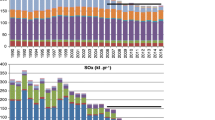Abstract
The European Commission has proposed air quality standards for NO2, SO2 and PM10 to be in force by 2010. The present paper presents a study that gauged their costs and benefits. An analysis of the expected emissions for 2010 (reference emission scenario), using simplified air quality models, showed that non-compliance with these standards will occur in cities only, not in rural areas. Most compliance problems are expected for PM10, least for SO2. Central estimates of the costs to meet standards range from 21 MECU (SO2), to 79 MECU (NO2) to 87--225 MECU (PM10). The estimated benefits are 83--3783 MECU (SO2), 408--5900 MECU (NO2), and 5007--51247 MECU (PM10). Uncertainties are high, due to errors and incertitude in various steps of the methodology, mainly the estimation of the human health effects, in particular effects on mortality, and in the valuation of a statistical life. In the case of PM10, additional uncertainty results from the small size of the air quality database. Notwithstanding the uncertainties, the indications are that the benefits exceed the costs.
Similar content being viewed by others
References
Amann, M., I. Bertok, J. Cofala, F. Gyarfas, C. Heyes, Z. Klimont and W. Schopp (1997), Cost-effective Control of Acidification and Ground Level Ozone. First Interim Report to the European Commission, DG XI, Brussels.
Barret, K. and E. Berge (eds.) (1996), Transboundary Sir Pollution in Europe, EMEP MSC-W report 1/96 part and 2, Oslo.
Berdowski, J. M. M., W. Mulder, C. Veldt, A. J. H. Visschedijk and P. Y. J. Zandveld (1997), Particulate emissions (PM 10-PM 2.5-PM 0.1 ) in Europe in 1990 and 1993, TNO, Apeldoorn.
Chow, J. C. and D. M. Ono (eds.) (1992), PM 10 Standards and Non-Traditional Particulate Source Controls, Vol. 1., A&WMA, Pittsburgh PA.
Coopers and Lybrand (1996), Cost-benefit Analysis of the Different Municipal Solid Waste Management Systems: Objectives and Instruments for the Year 2000, Final Report, European Commissions, DGXI, Brussels.
DGXIa (1996), The European Auto-Oil programme, EC DGXI, Brussels.
DGXIb (1996), Air Quality Report of the Auto-Oil Programme, EC DGXI, Brussels.
DGXVII (1996), Energy in Europe: European Energy to 2020 — A Scenario Approach, Directorate General for Energy (DG-XVII), European Commission, Brussels, Belgium.
DGII (1995), A Welfare Costs Assessment of Various Measures to Reduce Pollutant Emissions from Passenger Road Vehicles for the Year 2010, EC-DGXII (II-B-4), No. II/576/95-EN.
EPA (1993), The Benefits and Costs of the Clean Air Act, 1970 to 1990, draft May 3 1996, US Environment Protection Agency, USA.
EFTEC (1996), Research into Damage Valuation Estimates for Nitrogen Based Pollutants, Heavy Metals and Persistent Organic Pollutants, Main report 1, Economics for the Environment Consultancy Ltd., Belgium.
ExternE (1995a), Externalities of Energy, Vol. 2, Methodology, European Commission DGXII, SRC, Report nr. EUR16521EN, Brussels.
ExternE (1995b), Externalities of Energy, Vol. 3, Coal and Lignite, European Commission DGXII, SRC, Report nr. EUR16522EN, Brussels.
Groenskei, K. E., S. E. Walker and F. Gram (1993), ‘Evaluation of a Model for Hourly Spatial Concentration Distributions’, Atmos.Environ. 27B(1), 105-120.
Jaarsveld, J. A. van (1990), An Operational Atmospheric Transport Model for Priority Substances; Specifications and Instructions for Use, RIVM Report nr. 22501002, Bilthoven, The Netherlands.
Jaarsveld, J. A. van (1995), Modelling the Long-term Atmospheric Behaviour of Pollutants on Various Spatial Scales, PhD thesis. ISBN nr. 90-393-0950-7, Universiteit Utrecht, Faculteit Natuur en Sterrenkunde, Utrecht.
Jol, A. (1995), Kosteneffectiviteit van milieumaatregelen in de industrie (Cost-Effectiveness of Environmental Measures in Industry) Part B., VROM — Lucht & Energie 120, Leidschendam.
Krupnick A., K. Harrison, E. Nickel and M. Toman (1996), ‘The Value of Health Benefits from Ambient Air Quality Improvements in Central and Eastern Europe: An Excercise in Benefits Transfer’, Environmental and Resource Economics 7, 307-332.
Metroeconomica (1996), Green Accounting in Europe. The Role of Damage Estimation. Four Case Studies (draft), DGXII Contract. Joule CT-0316.
Navrud, S. and G. J. Pruckner (1997), ‘Environmental Evaluation — To Use or not to Use. A Comparative Study of the United States and Europe’, Environmental and Resource Economics 10(1), 1-26.
Olsthoorn, A. A., C. Dorland, H. M. A. Jansen, M. van Drunen, A. Bartonova, J. Clench-Aas, C. Guerreiro, J. F. Henriksen, S. Larssen, J. Pacyna and M. Amann (1998), Economic Evaluation of Air Quality Targets for Sulphur Dioxide, Nitrogen Dioxide, Fine and Suspended Particulate Matter and Lead, European Commission, ISBN-92-828-3063-2, Luxembourg.
Slørdal, L. H. and S. E. Walker (1997), Spredningsberegning av NO x, NO 2 og PM 10 for Oslo, Drammen, Bergen og Trondheim (Dispersion modelling of NOx, NO2 and PM10 for Oslo, Drammen, Bergen and Trondheim), NILU OR./96.
Tegen, I. and I. Fung (1995), ‘Contribution to the Atmospheric Mineral Aerosol Load from Land Surface Modification’, J. Geophys. Res. 100, 18707-18722.
Touche and Ross (1995), A Cost-effectiveness Study of the Various Measures That Are Likely to Reduce Pollutant Emissions from Road Vehicles for the Year 2010, Edinburgh.
Turner, J. H. (1988), ‘Sizing and Costing of Electrostatic Precipitators, Part 2: Costing Considerations’, JAPCA 38(4).
Vatavuk, W. M. (1990), Estimating Costs of Air Pollution Abatement, Lewis Publishers, Chelsea, Michigan.
World Health Organisation (1996), Revised WHO Air Quality Guidelines (Hfa database, last updated November 1996), World Health Organisation, European Centre for Environment and Health, Bilthoven.
Zantvoort, E. D. G. van, R. J. C. F. Sluyter and S. Larssen (eds.) (1995), Air Quality in Major European Cities. Part II: City Report Forms, NILU/RIVM, RIVM Report No. 722401009, Bilthoven.
Author information
Authors and Affiliations
Rights and permissions
About this article
Cite this article
Olsthoorn, X., Amann, M., Bartonova, A. et al. Cost Benefit Analysis of European Air Quality Targets for Sulphur Dioxide, Nitrogen Dioxide and Fine and Suspended Particulate Matter in Cities. Environmental and Resource Economics 14, 333–351 (1999). https://doi.org/10.1023/A:1008362631700
Issue Date:
DOI: https://doi.org/10.1023/A:1008362631700




